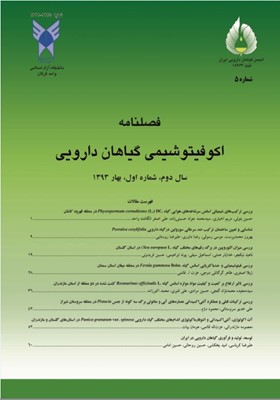بررسی ترکیبات فنلی و عملکرد آنتیاکسیدانی عصارههای آبی و متانولی برگ سه گونه از جنس Pistacia در منطقه سروستان شیراز
محورهای موضوعی : اکولوژی محیطیعلی خدیو سروستانی 1 , محمود دژم 2
1 - دانشکده کشاورزی، دانشگاه آزاد اسلامی واحد فسا، فسا، ایران
2 - دانشکده کشاورزی، دانشگاه آزاد اسلامی واحد فسا، فسا، ایران
کلید واژه: بنه, آنتیاکسیدان, پسته, ترکیبات فنلی و کلخنگ,
چکیده مقاله :
این پژوهش بهمنظور بررسی کمی و کیفی ترکیبات فنلی و توان آنتیاکسیدانی عصارههای آبی و متانولی برگ گونههای پسته اهلی (Pistacia vera L.)، بنه (Desf. Pistaciaatlantica) و کلخنگ (Pistacia khinjuk Stocks) در باغات منطقه سروستان شیراز در بهار 1391 انجام شد. آنالیز عصارهها با استفاده از کروماتوگرافی مایع با کارکرد بالا (HPLC) نشان داد که از نظر نوع و میزان ترکیبات فنلی تفاوتهای زیادی بین عصارههای گونههای مختلف وجود دارد. بیشترین و کمترین میزان ترکیبات فنلی به ترتیب در عصاره متانولی بنه و عصاره آبی پسته و کلخنگ یافت شد. ترکیبات وانیلین و اسید گالیک در عصارههای آبی و متانولی هر سه گونه وجود داشتند در حالی که ترکیب اسید سینامیک فقط در عصارههای متانولی هر سه گونه یافت شد و از نظر مقدار نیز بالاترین غلظت را در بین سایر ترکیبات به خود اختصاص داد. در این پژوهش توان آنتیاکسیدانی با اندازهگیری میزان شکار رادیکال آزاد 2،2-دیفنیل پیکریل هیدرازیل (DPPH) ارزیابی گردید و نتایج نشان داد که توان آنتیاکسیدانی عصارهها متفاوت بود و با افزایش غلظت، توانایی مهار رادیکال آزاد توسط عصارهها افزایش یافت، بهطوریکه در غلظت 3200 میلیگرم در لیتر عملکرد آنتی اکسیدانی عصارههای هر سه گونه بیشتر از استاندارد اسید گالیک بود. نتایج این پژوهش نشان داد که در بین عصارههای هر سه گونه، عصاره متانولی بنه دارای بیشترین توان آنتیاکسیدانی بود.
1.Abdelwahed, A., Bouhlel, I., Skandrani, I., Valenti, K., Kadri, M., Guiraud, P., Steiman, R., Mariotte, A.M., Ghedira, K., Laporti, F., Dijoox-Franca, M.G., and Chekir-Ghedira, L. 2007. Study of anti-mutagenic and antioxidant activities of gallic acid and 1, 2, 3, 4, 6-pentagalloyl glucose from Pistacia lentiscus: confirmation by microarray expression profiling. Chemico-Biological Interactions, 165: 1-130.
2.Alai, F.Q., Tawaha, K., El-Elimat, T., Syouf, M., El-Fayad, M., Abulaila, K., Nielsew, S.J., Wheatons, W.D., Falkinham, J.O., and Oberlies, N.H. 2007. Antioxidant activity and total phenolic content of aqueous and methanolic extracts of Jordanian plants: an ICBG Project, Natural Product Research, 21: 1121-1131.
3.Amri, I., Lamia, H., Mohsen, H., Gargouri, S., and Bassem, J. 2013. Chemical composition and antifungal activity of three anacardiaceous species grown in Tunisia. Science International, 1:148-154.
4.Benhammou, N., Bekkara, F.A., and Anovska, P. 2008. Antioxidant and antimicrobial of the Pistacia lentiscus and Pistacia atlantica extracts. African Journal of Pharmacy and Pharmacology, 2: 22-28.
5.Bruits, M., Asres, K., and Bucar, F. 2001. The antioxidant activity of the essential oils of Artemisia afra, Artemisia abyssinica and Juniperus procera. Phytotherapy Research, 15:103-108.
6.Cherbal, A., Kebieche, M., Madani, K., and El-Adawi, H. 2012. Extraction and valorization of phenolic compounds of leaves of Algeriam Pistacia lentiscus. Asain Journal of Plant Science, 3(11):131-136.
7.Gardeli, C., Vassiliki, P., Athanasios, M., Kibouris, T., and Komaitis, M. 2008. Essential oil composition of Pistacia lentiscus L. and Myrtus communis L.: evaluation of antioxidant capacity of methanolic extracts. Food Chemistry, 107:1120-1130.
8.Hirori, T., Takahashi, T. and Imamara, H. 1996. Wood extractives, XV, constituents of Pistacia chinensis wood. Nippon Mokuzi Gakkaishi, 12: 324-326.
9.Hosseinzadeh, H., Sajadi Tabassi, S.A., Milani Moghadam, N., Rashedinia, M., and Mehri, S. 2012. Antioxidant activity of Pistacia vera fruits leaves and gum extract. Iranian Journal of Pharmaceutical Research, 11: 879-887.
10.Huang, D., Ou, B., and Prior, R.L. 2005. The chemistry behind antioxidant capacity assays. Journal of Agricultural and Food Chemistry, 53:1841–1856.
11.Ilahi, I., Samar, S., Khan, I., and Ahmad, I. 2013. In vitro antioxidant activities of four medicinal plants on the basis of DPPH free radical scavenging. Pakistan Journal of Pharmaceutical Science, 26: 949-952.
12.Javanmardi, L., Stushnoff, C., Locke, E., and Vivanco, J.M. 2003. Antioxidant activity and total phenolic contents of Iranian Ocimum accessions. Food Chemistry, 83: 547–550.
13.Joshi, U.D., and Mishra, S.H. 2009. In vitro antioxidant activity of galls of Pistacia integerrima. Pharmacology online, 2:763-768.
14.Joukki, M., and Khazaei, N. 2010. Compare of extraction of phenolic compounds from Pistacia atlantica in different solvents. Advances in Biomedical Research, 8:361-365.
15.Kayani, S.A., Masood, A., Achakzal, A.K., and Anbreen, Sh. 2007. Distribution of secondary metabolites in plants of Ouetta-Balochistan. Pakistan Journal of Botany, 39:1173-1179.
16.Korkina, L.G. 2007. Phenyl propanoid compounds in plant response to different stress factors. Acta Physiologia Planta, 19: 257-268.
17.Naczk, M. and Shahidi, F. 2004. Extraction and analysis of phenolics in food. Journal of Chromatography, 1054: 95-111.
18.Peksel, A. 2008. Antioxidative properties of decoction of Pistacia atlantica Desf. Leaves. Asian Journal of Chemistry, 20: 681-693.
19.Silva, E.M., Souza, J.N.S., Rogez, H., Rees, J.F., and Larondelle, Y. 2006. Antioxidant activities and polyphenolic contents of fifteen selected plant species from the Amazonian region. Food Chemistry, 101: 1012–1018.
20.Souri. E., Amin, Gh., Dehmobed-Sharifabadi, A., Nazif, A., and Farsam, H. 2004. Antioxidant activity of sixty plant from Iran. Iranian Journal of Pharmaceutical Research, 3: 55-59.
21.Zayzafoon, G., Odeh, A., Mohzia, Y., and Allaf, A.W. 2011. Measurements of essential oil extract and antioxidants in Syrian
Myrtus Communis L. leaves using photochemilumine-science assay. Helvia Polonica, 57: 5-19.


